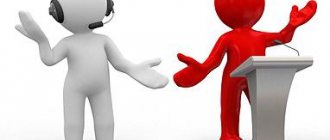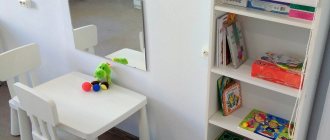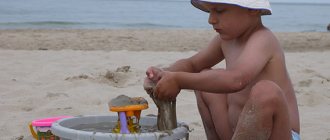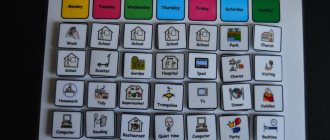Vocabulary is the number of words that a person understands and uses in speech. Moreover, he uses some of them, but not the other. Thanks to speech, we communicate with each other, expressing our thoughts and conveying them to our interlocutor, forming beliefs and developing intellectually. The richer, more literate and expressive a person’s speech is, the higher his level of education and cultural development is considered.
The lexical dictionary of children and adults consists of two categories:
- Active vocabulary is words that a person uses regularly in speech and writing.
- Passive vocabulary - consists of words that a person knows and perceives by ear, but does not use himself. Significantly exceeds the active dictionary.
There is no exact answer to what an adult’s reserve should be. For example, the dictionary of V.I. Dahl contains more than 200 thousand words, the academic dictionary of the Russian language - approximately 130 thousand words, the latest edition of the dictionary by S.I. Ozhegova – 70 thousand words. Obviously, even the most erudite people do not speak such a volume of vocabulary. According to the latest research data, an adult’s active vocabulary ranges from 5 thousand to 35 thousand words, passive - from 20 thousand to 100 thousand words.
Online tests help you check your vocabulary and evaluate it. But the results for the same person over different periods of time may differ, since he is constantly developing - he learns new words, but at the same time forgets or stops using previously learned ones.
As a rule, people with a rich vocabulary have more prospects, achieve goals faster, and achieve success in their careers, management, and show business. According to the majority, their work is more interesting, creative, extraordinary, and their achievements are higher. The same applies to your personal life. A person with a large vocabulary better formulates his thoughts, verbalizes desires and emotions, and due to this, he better finds a common language with people.
Vocabulary can be compared to a snowball: the more complex concepts a person knows, the more new words and terms he is able to perceive, remember and use in his speech. This is why it is necessary to develop a child’s speech from early childhood.
Development of vocabulary
A child’s lexical development consists of two aspects:
- Quantitative growth of vocabulary;
- Qualitative development – mastering the meanings of words.
In preschool age, the child’s vocabulary is enriched quickly. The period of speech development from 1 to 6 years is considered sensitive (sensitive) and the most successful for learning, favorable for the influence of the external environment. But the speed greatly depends on the environment in which it is located, so data on the number of words of preschoolers of the same age differ.
Let us consider the sensitive period of speech and vocabulary development in more detail.
Replenishment of a child’s vocabulary by year
In the first year of life, a child needs emotionally positive communication with adults for normal speech development.
The child learns words in such conditions when he can correlate the visual image of an object and its sound. If at this time he has the opportunity to manipulate the object (twist it in his hands, taste it), the new word will be remembered faster. For example, a mother gives the child a spoon and shows him what to eat with it.
By the age of one year, he uses only 5-9 words like “give” and “yum-yum”, correlates them with objects and actions, and develops reactions to the word. This is a preparatory stage for mastering speech.
At this age, it is already worth paying attention to enriching the child’s vocabulary. Regular and systematic classes will allow your child to grow up erudite and intellectually developed.
It is important under what conditions a child’s speech is formed and developed. It is best for others to speak correctly and slowly, since children at this age imitate adults. If a child hears incorrect speech, the wrong images of words are fixed in him, which is difficult to correct in the future.
1-1.5 years – hypersensitive phase, rapid accumulation of passive vocabulary and the beginning of the formation of the phonetic and grammatical aspects of speech. But if verbal communication is not enough, the emerging speech is quickly destroyed. Symptoms: delay in the appearance of the first words, “forgetting” already familiar words, stoppage of speech development.
At this age, objective and effective communication with adults begins. Passive vocabulary is rapidly expanding to 800-1000 lexical units. It consists of words used by parents in communicating with each other and with others.
By one and a half to two years, attention to the articulation of adults intensifies, the child repeats (echolalia) and pronounces certain words himself. It is normal if at this age he confuses sounds, distorts, rearranges or skips them.
The first words have a generalized semantic character - i.e. the same word can denote an object, an action, and feelings. You can understand a child in a situation, which is why such speech is called “situational”.
At one and a half years old, a child can distinguish in a photograph where dad is, where mom is, where grandma is, and where a brother or sister is, names and shows parts of the body (nose, mouth, eyes, etc.).
2.5-3.5 years – formation of phrasal speech. The transition to an abstract form of thinking, from monosyllabic phrases to complex structures. From the age of 3, the formation of the grammatical structure of speech begins. The child begins to construct sentences from primitive phrases that are not consistent with each other, coordinating and subordinating words.
During this period, there was a significant expansion and accumulation of vocabulary. The most common data on the quantitative growth of vocabulary in children:
- 1.6 – 10-15 words;
- end of 2 years – 300 words;
- 3 years – 1000 words.
From the age of 3, a child perceives everything through play. During this period, he consciously names objects and points to them with gestures, pays attention to color, shape, size, certain qualities of objects and phenomena, and also understands the difference between the words “one” and “many.”
What a 3 year old child should know:
- what are the names of family members, loved ones, pets;
- names of toys (pyramid, doll, ball, car, puzzle, etc.)
- names of dishes and cutlery (plate, spoon, fork, bowl, pan)
- names of clothes (jacket, dress, jeans, T-shirt, shorts, etc.);
- names of food products consumed in the family;
- spatial concepts (left, right, bottom, top);
- simple geometric shapes (circle, square, rectangle, triangle, star)
- names of animals and their young (hen-chick, dog-puppy, cow-calf, sheep-lamb).
- at least 5-10 plant names;
- names of seasons and weather phenomena (rain, snow, wind, sun, moon).
A 3-year-old child's vocabulary development is based on memorizing the meanings of nouns and verbs. Since at this age children cannot describe an object or their state using words, there is no point in focusing on adjectives and adverbs. At this age, it is enough to know the names of some sensations and states (warm, hot, cold, painful, tasty).
By the age of 3, a child develops “inner speech.” It becomes a means of his intellectual and speech development. He constantly involves an adult in the process of communicating with himself. Any mental stress and sensory deprivation at this age can provoke delayed speech development and lead to speech pathology (stuttering, mutism, speech negativism).
It is normal if a child at this age makes pauses not only between individual phrases, but also in the middle of words (this is dysrhythmia of a speech utterance, which indicates the intensive formation of intraspeech programming). Also, repetitions of words, combinations and even syllables (physiological iterations) appear in speech. An important component of speech during this period is speech breathing (the child can begin to speak in any phase of the respiratory act). It happens that in the process of speaking, the vegetative system actively reacts - the child blushes, feels tension in the muscles, and breathes quickly.
3.5-5 years – full understanding of adult speech, instructions, speech becomes a means of communication.
Children 3-5 years old learn to use certain words by repeating after adults, as well as in the process of interacting with the objects they talk about. In the vast majority of cases, the child attaches a literal meaning to spoken words. For example, the word “friendship” will be learned literally by a 5-year-old child: we play together, we walk hand in hand. Only after 11 years, according to Piaget's theory, does he begin to understand that friendship is based on trust, mutual assistance, common interests, etc. (since at the same time he begins to understand such abstract concepts as trust, betrayal, mutual benefit).
At this age, the child has many questions like “Why?”, “Why?” etc. Also at this age, children master generalization (a dog is not only a toy at home, but also a drawing in a picture, a neighbor’s pet). Particular attention should be paid to the formation of sound pronunciation, as disturbances in the pronunciation of whistling, hissing and sonorant sounds may occur.
At 4 years old, a normotypical child uses mostly simple sentences, but also confidently constructs compound and complex sentences. At this age, he is able to compose a story of 40-50 sentences without the help of adults, which indicates mastery of monologue speech.
The highest stage of word integration occurs, since the child’s brain already contains the result of previously acquired knowledge, and generalizations appear. At this age, children often name the category of an object rather than the object itself, which complicates the process of understanding for their parents.
The volume of the dictionary is 1900-2200 words. New thematic groups and categories that children of this age master:
- understanding and expression of feelings and emotions (joy, fun, anger, anger, resentment);
- characteristics of objects (size, color, temperature);
- diminutive forms of words (mommy, bush, fox).
At this age, the child fully understands how a word is formed. Therefore, he develops the skills of creating groups of words with the same root by adding prefixes and suffixes: mouse - little mouse, drink - drank. At the same time, he understands the differences between words with the same root from the same group: a cat is a large animal, and a kitten is a small cub of a cat.
After five years, there is also a sharp jump compared to the previous period - the number of words doubles, the vocabulary is 3000-4000 words. The number of lexical units increases sharply due to precisely the same root words: “cat-cat-cat-kitten”, “bucket-bucket”. The meanings of words are further enriched and clarified, but the child can still use them inappropriately.
At the age of 5-6 years, the skill of relating a new word not to one object, but to many appears. When learning new words at this age, children sometimes do not realize the full meaning of their content, so there is an erroneous use of words, a narrowing and expansion of the boundaries of their meaning and application. This happens because they fluctuate between concrete and abstract experience (before this, they were absolutely sure that only what they see exists).
This is also the period of formation of contextual speech, i.e. The child himself comes up with a monologue and voices it. He launches a very complex mechanism for the transition of internal plans into external speech. The central nervous system is most tense at this age, as at 3 years old.
During the period of 5-7 years, “failures” of speech breathing occur when using complex phrases and long pauses due to difficulties in forming a lexico-grammatically correct statement. Monologue speech may not be sufficiently formed due to mental stress and limitations of communication in the natural environment.
An important stage in speech formation in preschool age is word creation. The child himself comes up with new words, taking familiar nouns or nouns and verbs as a basis. For example, he may call his hand “nose bag” from “carrying a bag.”
Topics that a child aged 5-7 understands:
- time and intervals (hour, minute, week, year), seasons;
- using numerals using grammar (five chairs, third apple);
- names and surnames of family members, prominent personalities (favorite musical performers, cartoon characters);
- names of attractions and holidays;
- the concept of space (horizon, sky, space, Universe, around the corner, in another city);
- colors and shades, professions and sports, body parts of people and animals;
- vehicles, household items;
- wild animals, exotic plants and trees, fruits, vegetables, flowers;
- words denoting emotions and their evaluations (positive, negative).
The older the child, the less dependent he becomes on the sensory situation. The semantic content of words gains strength only towards the end of middle preschool age due to the assimilation of new knowledge about the world around us. Also during this period, children develop an aesthetic attitude towards words and speech. For example, at the age of 5, children can use metaphors, but they do this consciously only from high school age.
At the end of middle preschool age, the acquired language becomes truly native to the child.
From the age of 6-7, reading is important for a child’s education. This is the time when he already has a fairly large stock of knowledge about the world in which he lives, and the skills of inventing, composing and showing creativity are actively developing. At this age, reading is a source of emotional experience for children and contributes to their mental and speech development. The task of an adult is to instill in children a love of reading instead of watching cartoons and videos on YouTube, and to explain that a book (written language) is a source of knowledge.
When children enter school, testing is required to determine the level of their speech development. To avoid learning problems, it is recommended to first assess your child’s vocabulary and fill in existing gaps.
Norm of speech development in the period from 6 to 7 years
Features of speech development at 6-7 years old:
- the vocabulary is dominated by nouns;
- synonyms and antonyms are used;
- words are combined in meaning;
- the properties and quality of objects are indicated;
- complex sentences include participial and participial phrases;
- connecting, adversative and disjunctive conjunctions are used;
- speech is emotionally colored and expressive;
- statements are meaningful and accurate.
By the beginning of school, the child’s communication and speech abilities are developed, he is ready to build communication with peers and adults, and use his speech as a means of mastering a new activity—learning. At school, children improve their speech skills and master written language.
How to help your child develop a good vocabulary?
In order for your child’s vocabulary to develop correctly, you need to constantly communicate with him. The extent to which this communication is complete is shown by the volume and quality of the preschooler’s vocabulary. Therefore, it is recommended to regularly introduce the child to new objects and phenomena, name them, explain the features and characteristics of each. It is also important to pay attention to conversations with the child, ask him questions, create situations in which it is possible to identify shortcomings in the child’s understanding and use of words. The more active the family’s lifestyle, the more favorable conditions are created for expanding the child’s vocabulary. This is not only traveling to other cities and countries, you can go to the theater, circus, or zoo. Thus, the regularly replenished vocabulary is systematized, ordered, and put into semantic fields.










